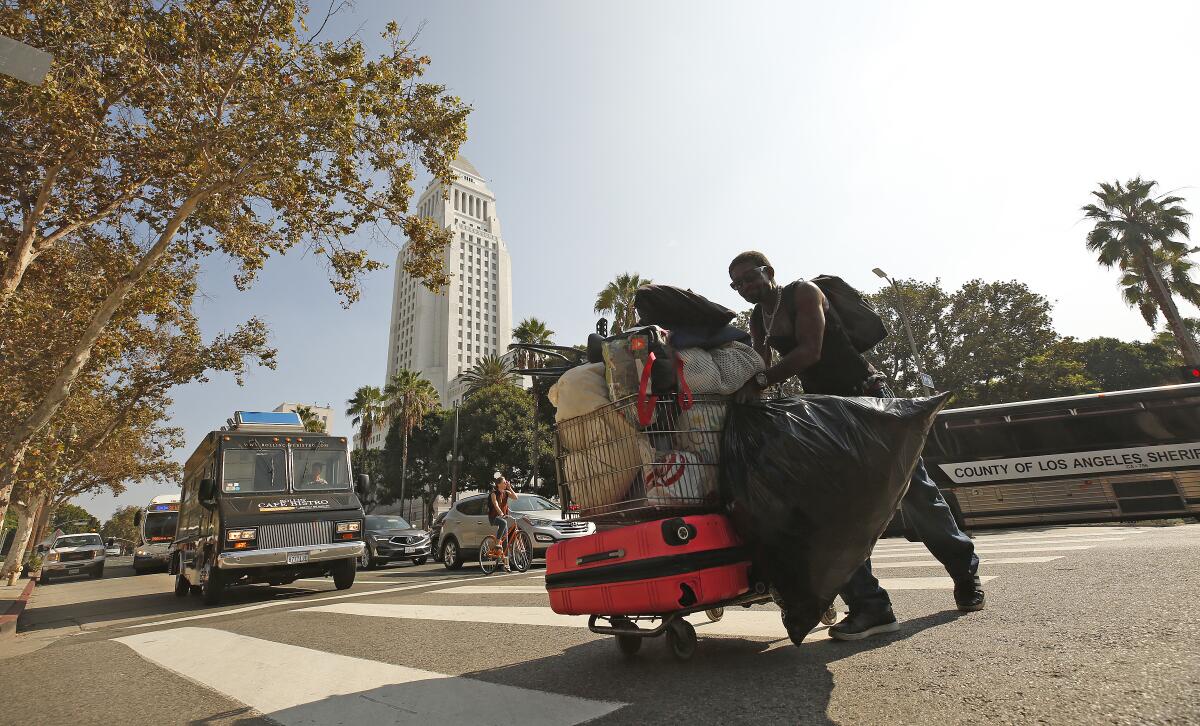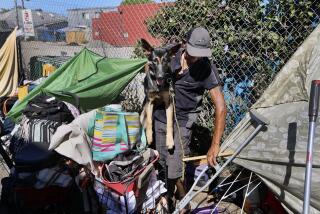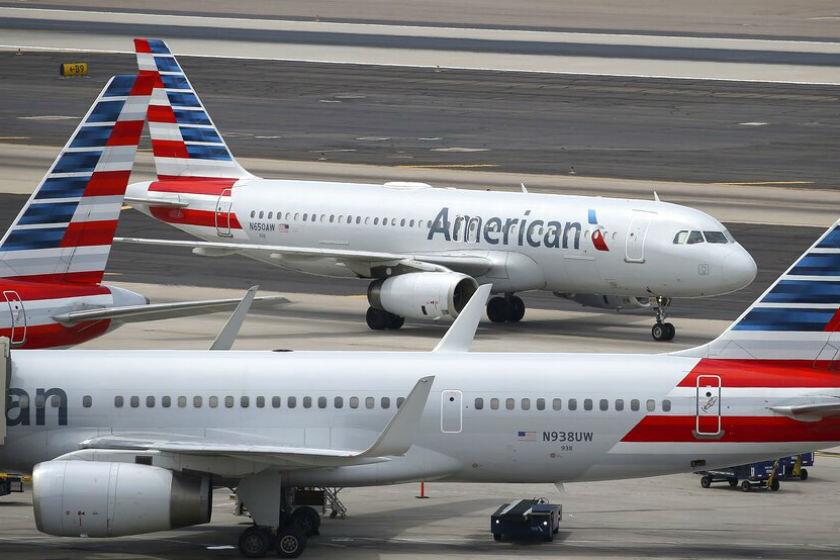L.A. announced more ‘sensitive’ cleanups for homeless camps. Now it’s taking a harder line

Last summer, Los Angeles Mayor Eric Garcetti declared that the city was launching a new system to clean up the trash and filth around homeless encampments, calling it “an even more nimble, flexible, targeted and sensitive approach.”
But the Comprehensive Cleaning and Rapid Engagement system — known as CARE — quickly spurred concerns at City Hall. Just months after Garcetti and other officials heralded its rollout, some council members lamented that streets looked worse than before. Council President Nury Martinez said that L.A. must lead with compassion, but “we also have to restore order in our streets.”
Sanitation officials said Tuesday that they were ushering in numerous changes, including planning for police presence at cleanup sites with “documented histories of escalation or aggressive or confrontational behavior” and giving council members more control over which areas are cleaned and how often.
They also said that all cleanup teams would “fully enforce” municipal rules that limit the quantity of items that can be kept on the street if people refuse to voluntarily comply, after council members complained that some workers appeared too hesitant to crack down.
The move marks the latest turn in a long-standing battle at City Hall over how Los Angeles should handle cleanups.
Garcetti and council members have faced mounting frustration about trash as tens of thousands of people sleep on city streets. But homeless people and their advocates have urged the city not to haul off things they need for survival.
“In a city where three unhoused people die per day, it’s irresponsible and, frankly, is life-threatening to continue these strong enforcement policies,” said Nicolas Emmons, a member of the advocacy group KTown for All, at Tuesday’s meeting.
Street Watch L.A. organizer Tommy Kelly excoriated council members, saying that after a brief rollout, “you throw up your hands and said, ‘Oh well, guess we have to go back to sweeping everything and terrorizing people.’ Because that’s what this policy is.”
The CARE program was initially seen as a step forward by groups in the Services Not Sweeps coalition, which had pushed to overhaul cleanups.
It would send the same teams to the same neighborhoods over time, allowing workers to build trust with people on the streets, and bring out more trash bins and mobile bathrooms. When the new system was launched in October, outreach workers from the Los Angeles Homeless Services Authority started regularly embedding with sanitation teams during cleanups.
The homeless services agency told its workers the goal was to shift the focus away from strict enforcement of Municipal Code 56.11, which limits what people can have on the street, and move it toward “improved public health outcomes and supporting unhoused Angelenos,” according to a September presentation. Outreach workers would “be the first point of contact” with homeless people.
Within weeks, CARE was facing complaints.
In an October email to sanitation officials, first obtained by blogger Adrian Riskin, a Garcetti aide said there had been concerns about “extremely lenient enforcement,” mentioning that she had heard that some teams believed they had to visit an encampment five times before cracking down on trash or bulky items.
In November, CARE program supervisors attended another city training where they were told that sanitation workers were the only people with the power to decide what would be tossed out and that “compliance should be achieved on the first visit.” In December, council members sharply criticized the program at a committee meeting.
“The fact that we haven’t done enough outreach does not give anyone — whether they’re housed or unhoused — the right to violate the law and to make our neighborhoods less sanitary,” Councilman Paul Krekorian said in December.
Councilman Mitch O’Farrell complained that decisions about where to clean had sidestepped his office. And in a later interview, Councilman Joe Buscaino argued that police officers should be automatically deployed with the teams, rather than being on call, in order to protect workers and maximize the hours allocated for cleanups.
If police are not there and cleanup crews are facing a “combative individual, they will take a step back and move on,” Buscaino said. “And when you move on and don’t address the issue, the trash will pile up.”
At the corner of 3rd and Main streets downtown, Anthony Angel tinkered with the red frame of a bicycle Tuesday as his dog Gunner slumped in their tent. He said he regularly loses his belongings during cleanups — sometimes clothing, sometimes his insulin.
“They give you 30 minutes to pack up your belongings. They will throw all your stuff out,” Angel said, complaining that police “are there to be the bullies.”
The Los Angeles Police Department’s homeless coordinator, Cmdr. Don Graham, said police are not being called out by CARE very often, pegging the rate at 8.2% of cleanups in December and lower in other months. Graham argued that low rate was a sign that city workers were building ties with homeless people that reduced the need for police intervention.
Before the program was begun, Services Not Sweeps activists had protested the fact that police officers would still be involved in cleanups at all, arguing that it undermined outreach. Jed Parriott, a Street Watch L.A. organizer, said that over time, the focus of the program seemed to have shifted back toward enforcing city rules, with outreach taking a back seat.
“We all want trash picked up. I don’t want to see needles on the sidewalk either. But the answer is trash pickup and sharps containers,” Parriott said. “Throwing out everyone’s stuff again will not do anything.”
Some said the city had effectively rolled back the program already.
“It is exactly the same” as before, said one homeless services provider, who declined to be named because she lacked authorization to speak publicly. “Except that we’re present. It ends up damaging outreach on the whole.”
Garcetti spokesman Alex Comisar said that despite such remarks, the November training “was not the result of any changes to the program,” calling it “a quality control measure to ensure everyone understands their roles.”
Sanitation officials said that starting this week, there will be several adjustments to the citywide program: Police officers, who have been deployed in the same zones as cleanup teams so sanitation workers could call for help, will now be sent out with cleanup teams at any sites where city officials have safety concerns.
Council offices will now have more control over which areas are cleaned up. And cleanup teams will “fully enforce” 56.11 at every site they visit, ensuring that bulky or hazardous items are impounded and thrown away, sanitation officials said in a report.
Despite the complaints, sanitation officials said the CARE program had doubled the number of cleanups performed monthly in Los Angeles.
Krekorian said Tuesday that although he had voiced concerns, a “softer touch” had generally worked in his Valley district, where homeless people had gotten trash cans and were keeping their encampments tidier than before.
The downside of that softer touch, he said, was “inconsistent messaging” about what people could keep with them on the streets. Still, Krekorian said, “I think we’re getting closer to the right balance.”
Times staff writer Benjamin Oreskes contributed to this report.
More to Read
Sign up for Essential California
The most important California stories and recommendations in your inbox every morning.
You may occasionally receive promotional content from the Los Angeles Times.











